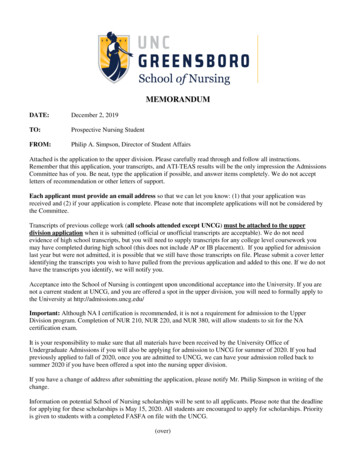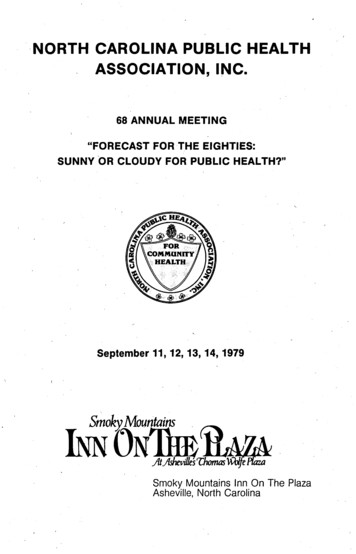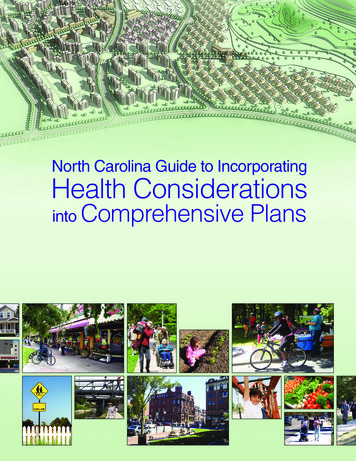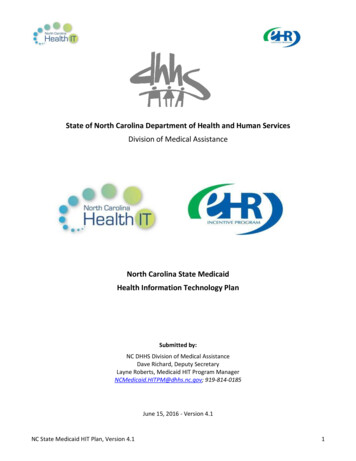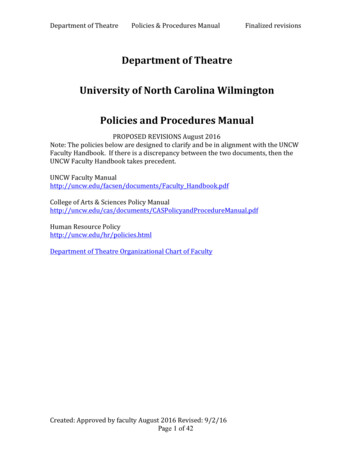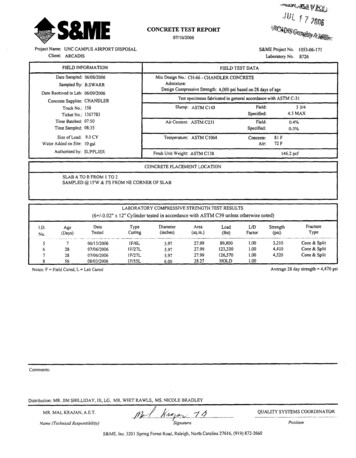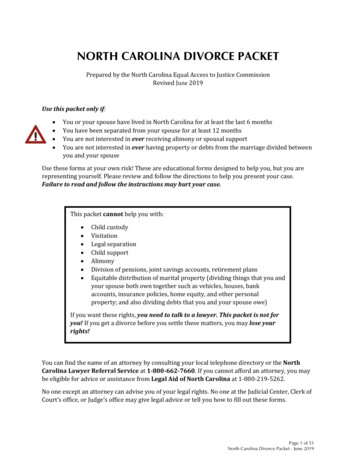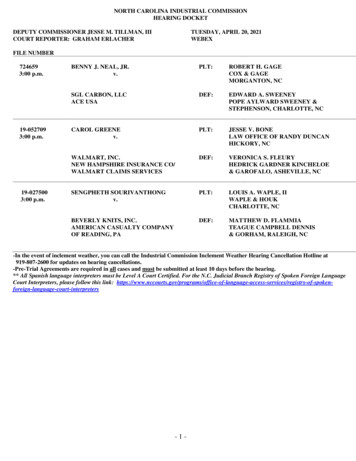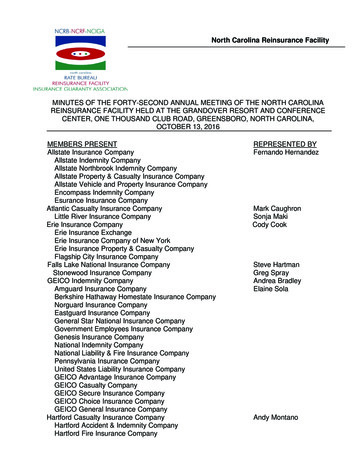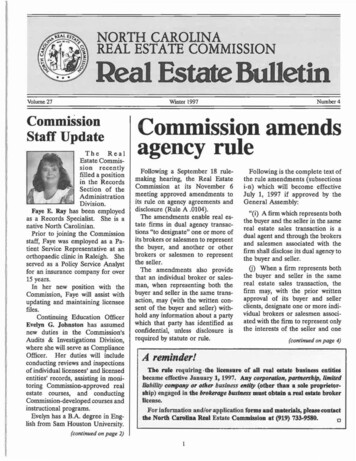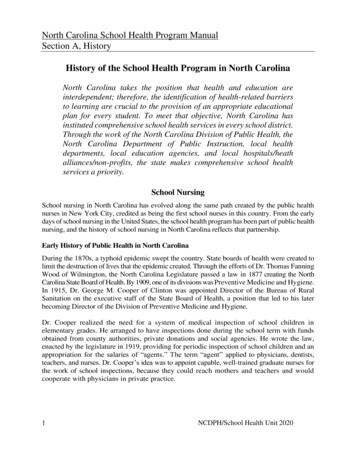
Transcription
North Carolina School Health Program ManualSection A, HistoryHistory of the School Health Program in North CarolinaNorth Carolina takes the position that health and education areinterdependent; therefore, the identification of health-related barriersto learning are crucial to the provision of an appropriate educationalplan for every student. To meet that objective, North Carolina hasinstituted comprehensive school health services in every school district.Through the work of the North Carolina Division of Public Health, theNorth Carolina Department of Public Instruction, local healthdepartments, local education agencies, and local hospitals/heathalliances/non-profits, the state makes comprehensive school healthservices a priority.School NursingSchool nursing in North Carolina has evolved along the same path created by the public healthnurses in New York City, credited as being the first school nurses in this country. From the earlydays of school nursing in the United States, the school health program has been part of public healthnursing, and the history of school nursing in North Carolina reflects that partnership.Early History of Public Health in North CarolinaDuring the 1870s, a typhoid epidemic swept the country. State boards of health were created tolimit the destruction of lives that the epidemic created. Through the efforts of Dr. Thomas FanningWood of Wilmington, the North Carolina Legislature passed a law in 1877 creating the NorthCarolina State Board of Health. By 1909, one of its divisions was Preventive Medicine and Hygiene.In 1915, Dr. George M. Cooper of Clinton was appointed Director of the Bureau of RuralSanitation on the executive staff of the State Board of Health, a position that led to his laterbecoming Director of the Division of Preventive Medicine and Hygiene.Dr. Cooper realized the need for a system of medical inspection of school children inelementary grades. He arranged to have inspections done during the school term with fundsobtained from county authorities, private donations and social agencies. He wrote the law,enacted by the legislature in 1919, providing for periodic inspection of school children and anappropriation for the salaries of “agents.” The term “agent” applied to physicians, dentists,teachers, and nurses. Dr. Cooper’s idea was to appoint capable, well-trained graduate nurses forthe work of school inspections, because they could reach mothers and teachers and wouldcooperate with physicians in private practice.1NCDPH/School Health Unit 2020
North Carolina School Health Program ManualSection A, HistoryFirst School Nurses in North CarolinaAs early as 1772, a North Carolina city, Salem, delivered public health services through a cityhealth department, with a physician, midwife and nurses. Greensboro, in Guilford County, holdsthe distinction of having established the first county health department in the United States in1911. In 1919, only 20 counties in the state had either a city or county health department. NorthCarolina’s local health department system was similar to that in other cities and counties across thenation.The first recorded school nursing in the state was offered by the Wayside Workers of the HomeMoravian Church in East and West Salem Schools in 1911. This began a movement wherebyvarious benevolent societies, civic organizations and public-spirited citizens marshalled forces toprovide services for school-aged children. In 1915, the Durham City School Board employed anurse, and in 1919, Guilford County hired two nurses to work in schools to improvemanagement of contagious diseases.Six nurses who were hired to work in the School Health Supervision Subdivision of the NorthCarolina Division of Preventive Medicine and Hygiene in 1919 are recognized as being theforerunners of school nurses in North Carolina. The school nurse movement in North Carolinawas largely due to the splendid efforts of these first six nurses. “They traveled on foot,horseback, on rafts, by boat, tram cars, ox-carts - any way to reach the ‘forgotten’ child” (Wyche,2011, p. 118). They worked in practically every county in the state, performing common healthfunctions of the day: weighing and measuring children, testing vision and hearing, examiningteeth and throats, taking family and child histories relative to immunization status, andassessing for the presence of communicable diseases.By 1922, school health efforts turned to correcting identified defects. Dr. Cooperinstituted two new programs: teaching oral hygiene and organizing tonsil and adenoid clinics.Six dentists gave demonstrations throughout the counties, using portable equipment to teachoral hygiene to school children. These efforts provided the impetus for the later developmentof a Dental Health Section in the State Board of Health. The nurses were instrumental inorganizing the tonsil and adenoid clinics under the directions of eye, ear, nose and throatspecialists. This clinic service continued for 12 years.Early Coordinated School HealthDuring Dr. Cooper’s tenure, the State Department of Public Instruction and the State Board ofHealth cooperated on behalf of school children. Not until Charles E. Spencer was hired by theDepartment of Public Instruction in 1938, however, was serious concern and planning for healthand physical education manifested. A 50,000 Rockefeller Board grant in 1939 fundedthe North Carolina School Health Coordinating Services, an advisory committee, to organizethe school health program. Field work was initiated, and additional grants made workshops andconsultants a reality. In 1947, the school health program expanded statewide and involved healthand physical education, concern for a healthy environment, and health services. The School2NCDPH/School Health Unit 2020
North Carolina School Health Program ManualSection A, HistoryHealth Coordinating Service Committee also produced and distributed curriculum guides toschools.Additional impetus was given to the development of the School Health Program in 1949 by aGeneral Assembly appropriation of 55,000 for each year of the biennium to establish a JointSchool Health Service Program of the State Board of Education and the State Board of Health.The School Health Coordinating Service Committee served as the designated administrative unitfor the two departments in the Joint School Health Plan developed by the two agencies in 1949.From 1949 on, the General Assembly appropriated funds (“School Health Funds”) annuallyto the State Board of Education to be allocated to local school administrative units for schoolhealth services. In the early years of the School Health Coordinating Service Committee, thefunds were used for public health nurse salaries, physician services for health assessment, andtreatment for the correcting of chronic remediable defects. However, the Budget AppropriationAct for the Biennium 1957-59 stipulated that “not less than 90 percent of the expenditures outof the appropriations for each year made to the State Board of Education under Nine MonthsSchool Fund for Child Health Program shall be expended for diagnosis and the correction ofchronic remediable physical defects of public school children. An amount not in excess of tenpercent of the appropriation for each year may be expended for case finding, health education,and intensive follow-up services.”This legislation affected the existing pattern of school health service delivery in North Carolinabecause the “Fund” could no longer be used to subsidize nurse salaries for needed case findingand follow-up services. Nursing was a necessary component of the Child Health Program forthe Board of Education. The health service program, financed by school health funds,constituted only a small part of the total school health program carried on by schools and healthdepartments in 1957.Between 1949 and 1957, the General Assembly did not appropriate monies requested for the StateBoard of Health’s general fund for aid to local health departments. However, the State Board ofHealth allocated about 330,000 for school health services each year.Effect of Special Education of Children on School Health ProgramsIn 1963, the School Health Coordinating Service Committee published a guide for planning atotal school health program entitled “Health Services in Our Public Schools.” Its contentsindicated that the State Board of Education and the State Board of Health were still planningtogether to provide for a school health program. Within five years, however, this committee wasdissolved.The dissolution of the committee may have been partially due to new directions from federallegislation and federal funding for school health services directed to Boards of Education. Forexample, the Elementary and Secondary Education Act (ESEA) was passed in 1965 and3NCDPH/School Health Unit 2020
North Carolina School Health Program ManualSection A, Historywas implemented in North Carolina in 1966. The act provided funds for nurses and othereducational support service professionals to work with educationally and emotionally deprivedchildren of school age. This included Native American and migrant children who wereconsidered to have special educational needs. The act also provided funding for the supportof instructional activities for the children identified as educationally disadvantaged.Under Title VI-B of ESEA, “funds were provided for initiation, expansion and improvement ofprograms and services for physically and mentally handicapped children at the preschool andelementary level.” The Education of the Handicapped Act (PL. 94-142) incorporated Title VI-Bof ESEA and broadened as well as strengthened the mandates of Boards of Education forimplementation.During the 1973 session of the North Carolina General Assembly (2nd session 1974), legislatorsratified “An Act to Establish Equal Educational Opportunities in the Public School; and ForOther Purposes.” This bill transferred administration of the School Health Fund from theDepartment of Public Instruction to the Department of Human Resources. From July of 1974until September 1999, the School Health Fund was used for the prevention, as well as thediagnosis and correction, of chronic, remediable physical defects of public-school children.Provision was made for the purchase of medications for eligible children when there was no otherfunding resource. The School Health Fund was not used for personnel salaries.In 1977, the General Assembly enacted legislation that became the framework for thedevelopment of a North Carolina State Plan for the implementation of PL 94-142. The billdefined the exceptional child, provided funding for educational support services personnel,spelled out protocols for identification and placement in the development of the educationalplacement plan, and called for parent involvement in the development of the educationalplacement plan. Rules were developed by the North Carolina Department of Public Instruction’sDivision for Exceptional Children. The rules called for the identification of these childrenthrough a community “Child Find” and referral mechanism.In 1986, the United States Congress passed the “Amendments to the Equal Education of theHandicapped Act” (PL 99-457) and additional amendments in 1991 through, the “Individualswith Disabilities Education Act” (IDEA) (PL 102-119). This new law reaffirmed all of thespecial education entitlement of PL 94-142 passed in 1976, but extended age eligibility down tobirth. Two new programs emerged: The Infant and Toddler Grant Program (Part C), servingchildren birth to three years: and the Preschool Grant Program (Part B), serving children threeto five. The Department of Public Instruction was chosen as the lead agency for The PreschoolGrant Program (Part B) of Public Law 99-457 and implemented it in the 1991-92 school year.This program provides non-discriminatory testing, placement in the least restrictiveenvironment, individualized education programs, related support services, and procedures fordue process for children aged three to five.4NCDPH/School Health Unit 2020
North Carolina School Health Program ManualSection A, HistoryNorth Carolina School Health Program ProgressIn 1978, the North Carolina General Assembly ratified “An Act to Establish a Statewide SchoolHealth Education Program Over a Ten-year Period.” This bill defined what was meant by“comprehensive school health education” and assigned responsibilities to the StateBoard of Education, the State Department of Public Instruction, and local educationaladministrative units for the development of a health education program for kindergarten throughninth grade. It called for the creation of a State School Health Education Advisory Committeeand local school health education coordinators for each county. The following year, on February16, 1979, the General Assembly ratified “An Act to Rewrite the Immunization Law.” This billlisted immunizations required by the Commission for Health Services and assignedresponsibility for the enforcement of the rules to the Department of Human Resources. The billalso required that a certificate of immunizations indicating that the child had received all of theimmunizations required by the General Statute 130-87 be presented to day-care facilities orschools as a condition for school attendance (K-12) by the 1980-81 school year.During 1979, state legislators passed several other bills with implications for school health: “An Act to Provide Sports Medicine and Emergency Paramedical Services andEmergency Life Saving Skills to Students in the Public Schools.”This bill:o appropriated monies for the provision of sports medicine and paramedical life-savingservices, ando appropriated monies for the in-service educational training of public-schoolpersonnel for the development of sports medicine and emergency paramedical skills. “An Act for the Defense of Certain Public-School Employees.”This bill:o defined the scope of duty of teachers to provide some medical care.o provided for legal defense mechanisms for public school employees againstwhom claims or civil actions are commenced for personal injury because of an actdone or omission made in the course of duties under General Statute 115C-307.o enabled public school employees when given such authority by the Board ofEducation or its designee, to: administer drugs or medications prescribed by a doctor upon writtenrequest of parents. give emergency health care when circumstances indicate that delay mightseriously worsen the physical condition or endanger the life of the pupil. perform any other first aid or life saving techniques in which the employee hasbeen trained in a program approved by the State Board of Education.The Basic Education Plan (BEP), enacted by the legislature in 1985, made sweeping changes inNorth Carolina’s education program. The plan spelled out the education that was to be availableto every student in the state. The BEP described a program of instruction that included5NCDPH/School Health Unit 2020
North Carolina School Health Program ManualSection A, Historytraditional curricula as well as “healthful living.” The program included support services suchas guidance, health and psychological services; staff ratios; staff development; and facilitiesstandards. The plan set a state-funding ratio for student support service positions, which includednurses. According to the BEP formula, there was to be one school nurse per 3,000 average dailymembership (ADM) with at least one nurse per county funded by the state. The BEP formulafor school nurses has not been changed since its enactment.A Kindergarten Health Assessment bill was ratified on May 1, 1987 with an effective date ofJanuary 1, 1988. That Legislation stated that every child who entered kindergarten in the publicschools was required to have a health assessment, the results of which were sent to the school.Principals were made responsible for reporting to the State the number of kindergarten studentsmeeting (or not meeting) this requirement. Exclusions from school resulted when a healthassessment was not received within the designated time frame.Progress for School NursingIn the fall of 1991, the North Carolina State Board of Education adopted a policy requiringall newly employed school nurses to hold national school nurse certification through either theAmerican Nurses Association or the National Association of School Nurses. The policy becameeffective July 1, 1993. The policy allows local education agencies (LEAs) to employ, if necessary,uncertified nurses; however, they must be hired with the stipulation that they become nationallycertified within three years of their hire date. (Note: As of 2010, national certification forschool nurses is available through the American Nurses Credentialing Center [ANCC] forrenewals only and the National Board for Certification of School Nurses [NBCSN] for bothrenewals and new certification.)A state salary schedule acknowledging both national certification and years of nursing experiencewas implemented in 1993. Beginning with the 1998-99 school year, certified school nursesemployed by the public schools were paid on the “G” salary schedule. Until national certificationis attained, the nurse’s salary is assigned according to the non-certified nurse schedule. During the2001 Session the General Assembly changed the requirements for the national certification ofschool nurses. The language allowed school nurses employed in the public schools prior toJuly 1, 1998 to avoid requirement for national certification in order to continue employment.“School nurses not certified by the American Nurses Credentialing Center or the National Boardfor Certification of School Nurses shall continue to be paid based on the non-certified nurse salaryrange as established by the State Board of Education.”By 1992, there was sufficient interest among nurses employed in school nursing to forman organization that would advance the goals of school health in North Carolina. The SchoolNurse Association of North Carolina (SNANC) was organized in that year to provide anopportunity for school nurses to: network with other school nurses. obtain professional resources, including continuing education; and advocate for quality school health services.6NCDPH/School Health Unit 2020
North Carolina School Health Program ManualSection A, HistoryThe members later formed regional groups to provide local networking. They also created alink between the SNANC Executive Board and the ANANC (American Nurses Association of NC)and to the National Association of School Nurses (NASN).In response to continued growth in the numbers of students with special health care needs,including those who were technology dependent, the North Carolina State Board of Educationadopted a policy entitled “Special Health Care Services”. This policy, enacted on July 1, 1995,required each local school district to make a registered nurse available for assessment, careplanning, and ongoing evaluation of students with special health care needs in the school setting.In 1992, the General Assembly appropriated funds for Comprehensive Adolescent Health CareProjects in the form of school-based and school-linked health centers. These health centersare located on a school campus (school-based) or affiliated with schools in the community(school-linked). They employ a variety of professional health care providers to increaseadolescents’ accessibility to primary care, mental health, nutrition, health risk educationcounseling and preventive health services. Most are sponsored by a health care organization. Thehealth centers in schools are established after broad-based community planning and endorsementand require informed, written parent permission prior to a student’s participation. By the end of2008, there were more than 50 school-based and school-linked health centers located across thestate.The School Health Nurse Consultant TeamIn 1995, the state agency then known as the North Carolina Department of Environment, Healthand Natural Resources (DEHNR) established regional school nurse consultant positions inaddition to the central office state school nurse consultant. These regional consultants wereplaced in four DEHNR regions across the state. They were added to expand professional schoolnurse technical assistance to local health departments and LEAs and to augment theconsultation provided by the state school nurse consultant. Two additional positions were addedin the spring of 1997.In 1996 after statewide organizational downsizing and restructuring, the Department ofEnvironment, Health and Natural Resources underwent a change with the personal servicesprograms of public health becoming a part of a newly organized Department of Health and HumanServices. In 1999, the Division of Public Health, which includes the school healthservices programs of the Women’s and Children’s Health Section, was established and is wherethe School Health Unit resides.Coordinated School Health Programs ContinueIn order to further promote the concept and work of coordinated school health services, NorthCarolina sought and received a grant from the Centers for Disease Control and Prevention(CDC) in 1998. Awarded to the Department of Public Instruction, the program, called NCHealthy Schools, supported the development of a planned and coordinated school health7NCDPH/School Health Unit 2020
North Carolina School Health Program ManualSection A, Historyprogram. The program consisted of eight components which included healthful schoolenvironment; health services; health education; physical education; counseling, psychologicaland social services; nutrition services; family and community involvement; and health promotionfor staff. These components were represented to some extent in the state education agency, statehealth agency, and in local school districts. The program’s design assisted in the development ofan infrastructure (system of supports) at the state level that supported the prevention and reductionof health risks statewide through the establishment of coordinated school health programs at thelocal level. The five-year grant was renewed twice.In 1998, the General Assembly enacted historic legislation to help thousands of uninsured childrenand adolescents get health insurance under the North Carolina Health Choice for Childrenprogram. Funded by the federal government and the state, this program provides free or lowcost health insurance to children whose families cannot pay for private insurance and who donot qualify for Medicaid. The legislation also provided for revision of the state’s School HealthFund guidelines. The new funding priorities included: 1) base-funding for school-based andschool-linked health centers, 2) provision of funds for emergency dental services, and 3) purchaseof bulk medications.In September 2002, a law addressing ‘Guidelines to support and assist students with diabetes,’N.C.G.S. 115C-375.3, was passed by the General Assembly. It required the State Board ofEducation to adopt guidelines for the development and implementation of individual diabetes careplans. The guidelines, written in consultation with the North Carolina Diabetes Advisory Council,reflected reference to the American Diabetes Association for the Management of Children withDiabetes in the School and Day Care Setting.Dr. Leah Devlin, (the state health director at the time) created a School Health Matrix Team in2002 to bring together all the Division of Public Health’s resources dedicated to the health ofstudents. The School Health Matrix Team formalized a system by which all of the Division’s“school health players” could work together around the CDC’s eight-component model ofcoordinated school health to improve the health status of students. In close collaboration withthe Department of Public Instruction, The Matrix Team sought to improve the health and academicachievement of students through strengthened school health programs and policies.In January 2003, the State Board of Education adopted the “Healthy Active Children” policy(HSP-5-000). In order for the policy to be fully implemented as required by the 2006-07 schoolyear, schools were expected to: conduct a needs assessment on health services and programs. provide an action plan to the North Carolina Department of Public Instruction byJuly 15, 2004; and provide progress reports by July 15, 2005 and 2006.In February 2003, the rule was changed regarding the emergency administration ofepinephrine to persons suffering an adverse reaction to agents that might causeanaphylaxis. While previous legislation had limited the administration of emergency epinephrine8NCDPH/School Health Unit 2020
North Carolina School Health Program ManualSection A, Historyto persons suffering an adverse reaction to insect stings, the rule change expanded the causesof anaphylaxis in persons who could be eligible to receive emergency treatment. The revisedrule continues to allow a physician to authorize other practitioners to train persons to administerepinephrine, making the physician doing so responsible for signing the application forms ofthese trained persons, prior to sending them to the North Carolina Office of Emergency MedicalServices (OEMS). This process was termed ‘credentialing’.Addressing Challenges in School HealthMajor changes in ensuing years dramatically affected the delivery of school health services.These included:1) an increase in the number and severity of illnesses in students who attend school,2) the marked increase of social morbidities such as substance abuse, homicide, suicide,child abuse and neglect, and violence,3) psychosocial and developmental problems, such as Attention Deficit/HyperactivityDisorder (ADHD), depression, and eating disorders,4) the impact of immigration, homelessness, and diverse cultural and linguistic groups,5) changes in family structure (divorce, remarriage, working parents), and6) threats of bioterrorism.School Nurse Funding InitiativeOver the years, North Carolina has tried to improve support resources to students, including a numberof attempts to improve the school nurse-to-students ratio. In 2003, the N.C. General Assemblyrequested a formal study regarding school health needs. A special provision was added to thebudget that required the State Board of Education to review the standards for the number ofschool nurses recommended in the Basic Education Program and to determine whether thesestandards were being met by the local school administrative units. The State Board wasalso asked to compare the current standards with standards recommended by national healthorganizations to determine whether the current standards were adequate to meet the changingneeds and demands for health services in the current and projected school populations. The StateBoard of Education made the following recommendations to the Joint Legislative EducationOversight Committee in February 2004: Expansion of school nurse services in order to reach a 1:750 ratio by the year 2014. Provision of a process for lead health officials of NC DPI and NC DHHS to collaborateand coordinate the successful planning and implementation of the recommendations forincreased school nurse-to-students ratio. Sustaining of current DPI standards and definitions of school nursing; and Encouraging ongoing dialogue with the Joint Legislative Education OversightCommittee to identify sources of revenue for expanded school nurse services funding.That spring, in 2004, the legislature appropriated funds for a School Nurse Funding Initiative(SNFI). The funds provided 65 time-limited school nurse positions over a two-year period and80 permanent school nurse positions. In July 2006, the General Assembly assured that the 659NCDPH/School Health Unit 2020
North Carolina School Health Program ManualSection A, Historytime-limited positions would be permanent, and appropriated funding to bring the total to 145 fulltime school nurse positions supported through the School Nurse Funding Initiative. In July 2007,additional funds were appropriated for an added 66 school nurse positions; further funding in July2009 and in July 2011 brought the total of school nurse positions funded by the SNFI allocation to235.75 by the start of the 2011-2012 school year.The SNFI funds authorization act stated that DHHS/DPH “shall provide funds to communities tohire school nurses” and that criteria for the awarding of funds would include determining areasof greatest need and greatest inability to pay for school nurses. The budget specified that thefollowing would be part of the criteria:1) current school nurse-to-students ratio,2) economic status of the community, and3) health needs of area children.All funds were to be expended for salary, fringe benefits, and training for direct school nurseservices. The allocation of the positions according to the criteria developed by DHHS/DPH andDPI increased the number of LEAs meeting the recommended ratio of one nurse to no more than750 students from 10 in the 2003-2004 school year to 42 by end of 2012-2013.Continued Provisions for the Health Needs of StudentsIn April 2005, a law addressing ‘Possession and self-administration of asthma medicationby students with asthma or students subject to anaphylactic reactions, or both,’ N.C.G.S.115C-375.2, was passed by the General Assembly. It required the local boards of education toadopt a policy authorizing a student with asthma or a student subject to anaphylactic reactions,or both, to possess and self-administer asthma medication on school property during the schoolday, at school-sponsored activities, or while in transit to or from school or school-sponsoredevents.More school nurses were provided by the State of North Carolina in 2006, when then-GovernorMichael Easley added 100 school nurses as part of Child and Family Support Teams in theschools. The initiative provided recurring state funds to team 100 school nurse positi
State boards of health were created to limit the destruction of lives that the epidemic created. Through the efforts of Dr. Thomas Fanning Wood of Wilmington, the North Carolina Legislature passed a law in 1877 creating the North Carolina State Board of Health. By 1909, one of its divisi
